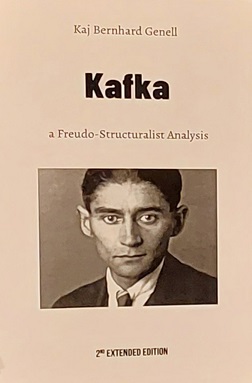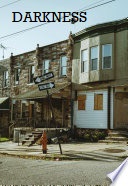
The "Kafkaesque" is not just an ordinary concept of style.
Kaj Bernhard Genell Author REAL SITE
- a Facts and Fiction Site
My book "Kafka- s Freudo-Structuralist Analysis" has a new take on Kafka.
Kafka used high-Romantic Ästhetik des Schwebens
and without this half ironic reference of his to the Romantic Tradition, there would have been
no Kafkaesque. The Kafkawsque - of course - is what most of all interests
us, when it comes to Kafka. But what - then - is meant by
the term "Kafkaesque"? We are - as our prime object of study
- looking into this Concept. THUS Kafka - a Freudo-Structuralist
Analysis is an analysis of Kafka's novels and short stories,
with special regard to the concept of the Kafkaesque. This book
concentrates on understanding what contributed to the famous Kafka
effect. The author explains the structural triplicity of a discourse
seen as consciousness. He also asserts how Freud, Romantic irony,
and Symbolistic literature simultaneously co-work as the mythical
subtext of Kafka's work.
Kafka created something that would become
part of defining Modern Man. Understanding Kafka is the road to
understanding Modernity. Many a Dissertation and many an Essay
on Kafka have dealt with the strange "dreamlike character" or
effect of Kafka´s novels and short stories. This has always
been dealt with as if the "kafkaesque" was brought into the
game by someone adding "Freudian symbols" to something. Nothing
could be further from the truth! This is what Genell´s book
Kafka - a Freudo-Structuralist Analysis (2021) shows.
Rather, the case is this: Kafka's structural, literary form is based upon a refined mega-structural narrative
split. It is the split between subject-"voice" and object-"voice" on the one hand, and human conscious and
unconscious mind, on the other. This is not easy either to describe or to understand! The uniqueness of
the works of Franz Kafka and the perplexing historical accuracy of the concept of Kafkaesque are both
phenomena that many readers and scholars have noticed over the years. Through the years, a fruitful
explanation of the uniqueness and accuracy of these works has been missing. Scholars have ever from
the 1930ies been noticing the extraordinary qualities of Kafka text.
Strange - Kafkaesque - features
have been attributed to the short stories and the novels of Kafka. The Kafka hero has - rightly -
been seen as a mere figure, and the alleged dream-like landscape universe has been seen as a characteristic,
and one has frequently been looking upon these entities, together with a few stylistic features, as
technical dominants in the shaping of the concept of the Kafkaesque. Genell´s Kafka - a Freudo-Structuralist
Analysis displays a model, together with a biographical survey and a historical perspective on possible influences,
that, reversely, forms a hermeneutic, actual explanation of these features, as well as to what is denoted by the concept,
from the perspective of a dynamic contextual center, explained in a model containing three levels, levels forming the
discourse, typical of Kafka.
This book tries to unravel the enigma of the concept by reference to the process of
creation and by Kafka´s implicit use of TWO unconscious levels within the universe of his most important works.
The veil of mystery may never be lifted regarding Kafka´s eerie classics of Modernity like it will never be
lifted when it comes to literature as a whole. Still, it might be essential - in order not to fall into any
metaphysical trap - to know about the technique behind the Kafkaesque to be able to reflect upon the Self-Consciousness
of Modern Man of the 20ieth century, a century so intensely marked by a dialogue between society and the works and
ideas of Sigmund Freud. Self-consciousness of Man, as it appeared with St. Augustine, the great Italian Renaissance
writers, Erasmus, Shakespeare, Montaigne, the German secular Romantics, and Hegel, swiftly developed into something
even much more complex with the appearance of Freud and the groundbreaking publication of his Traumdeutung in the
year of 1900, and, more so, with the creation of the Kafkaesque, with the works of Kafka, around the year of 1912.
The birth of the Kafkaesque can be dated to the night in the autumn of 1912 when Kafka wrote Das Urteil.
The book,
Kafka - a Freudo-Structuralist Analysis revolves solely around this strange split of consciousness and the consequences of this split.
The Kafkaesque is brought about by two phenomena, and Genell is in his book discussing only the first one. 1.) A
literary trick, built upon a split Unconscious ( strange as it of course may sound, and difficult -) and 2.) a
unique mental sensibility. WHAT IF one had a Dream of a Dream and the two of them could communicate?? That is
what happens in a Franz Kafka story! The book Kafka - a Freudo-Structuralist Analysis deals with Kafka´s novels
and short stories from the aspect of the Kafkaesque, and it does so by looking for the means that create this effect.
These means turn out to be largely technical. Thus, this book, Kafka - a Freudo-Structuralist Analysis, shows how Kafka
uses a narratological split, split consciousness, and SPLIT Unconscious of the hero to create the Kafkaesque by a rare
trick. This new book shows how Kafka became one of the most prominent artists to create and define Modernity. Kafka
took part in the thrilling creation of Self-conscience of the 20ieth century, marked by a constant dialogue with
Freud and his works. Self-Conscience as Man knew it since St. Augustine, the Italian renaissance writers Erasmus,
Shakespeare, and Montaigne, and later with the secular Romantics and Hegel swiftly developed within Modernism into
something much more complex, primarily with the appearance of Freud's "Traumdeutung" in the year of 1900. And Kafka
- rebutting Schnitzler - then set out to complete it all. >
The works of Kafka appeared as a reaction to: 1.) Modern
times, to 2.) his own personal alienation, and to 3.) Freud. Kafka's answer to Modernity - to the modern condition
- was astonishingly complex, but it turned out to be very accurate and accomplished right from the beginning.
When other reactions to the Modern Condition, like Hugo Ball, Appolinaire, and Dada, displayed a picture of
a chaotic and rebellious attitude to reason and morals, Kafka, much like Rimbaud actually, showed a far
more complex ability to make modern society's human-understandable itself, in a universal narrative. Kafka,
in exploring the Unconscious, as by Freud, and in doing so using a Romantic "AEsthetik des Schwebens," is
the unique discoverer of the marvels of mind, and is, in this, equal to Freud.
Kafka - a Freudo-Structuralist
Analysis sets out to explain how the Kafkaesque itself generates - even today, 100 years after its birth -
an interrogation that scrutinizes the Freudian theory and our conception of the unique human consciousness.
Kafka´s relation to Freud was somewhat like a son's relation to the father. Hence, Kafka did not acknowledge
Freud's discoveries, methods, and notions as truths. But he saw them - ironically enough - as facts.
And in a sense, they were. Freud's views were historical facts in their profound influence on the
Mind and Society of the century. Kafka used Freud as part of the revealing of Modern Myth, and the
myths used by Modernity. Kafka used Freud, but Kafka added on top of Freud´s model of the human
psyche another split to human consciousness in his literary universe.



 online BOOKS ON THIS SITE:
online BOOKS ON THIS SITE:
 Book on Kafka (2020)
Book on Kafka (2020) More books and writings,
PDFs,
More books and writings,
PDFs,  Kafka and Freud - an Oedipal Relation (2025)
Kafka and Freud - an Oedipal Relation (2025)

 ONLINE VERSION!
ONLINE VERSION!







